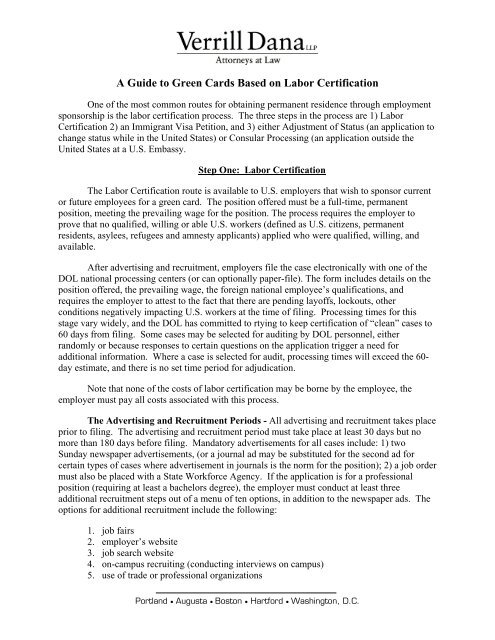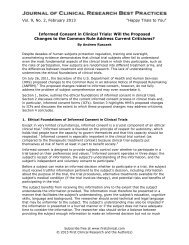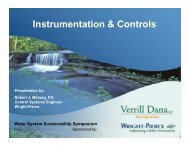A Guide to Green Cards Based on Labor Certification - Verrill Dana
A Guide to Green Cards Based on Labor Certification - Verrill Dana
A Guide to Green Cards Based on Labor Certification - Verrill Dana
You also want an ePaper? Increase the reach of your titles
YUMPU automatically turns print PDFs into web optimized ePapers that Google loves.
A <str<strong>on</strong>g>Guide</str<strong>on</strong>g> <str<strong>on</strong>g>to</str<strong>on</strong>g> <str<strong>on</strong>g>Green</str<strong>on</strong>g> <str<strong>on</strong>g>Cards</str<strong>on</strong>g> <str<strong>on</strong>g>Based</str<strong>on</strong>g> <strong>on</strong> <strong>Labor</strong> Certificati<strong>on</strong>One of the most comm<strong>on</strong> routes for obtaining permanent residence through employmentsp<strong>on</strong>sorship is the labor certificati<strong>on</strong> process. The three steps in the process are 1) <strong>Labor</strong>Certificati<strong>on</strong> 2) an Immigrant Visa Petiti<strong>on</strong>, and 3) either Adjustment of Status (an applicati<strong>on</strong> <str<strong>on</strong>g>to</str<strong>on</strong>g>change status while in the United States) or C<strong>on</strong>sular Processing (an applicati<strong>on</strong> outside theUnited States at a U.S. Embassy.Step One: <strong>Labor</strong> Certificati<strong>on</strong>The <strong>Labor</strong> Certificati<strong>on</strong> route is available <str<strong>on</strong>g>to</str<strong>on</strong>g> U.S. employers that wish <str<strong>on</strong>g>to</str<strong>on</strong>g> sp<strong>on</strong>sor curren<str<strong>on</strong>g>to</str<strong>on</strong>g>r future employees for a green card. The positi<strong>on</strong> offered must be a full-time, permanentpositi<strong>on</strong>, meeting the prevailing wage for the positi<strong>on</strong>. The process requires the employer <str<strong>on</strong>g>to</str<strong>on</strong>g>prove that no qualified, willing or able U.S. workers (defined as U.S. citizens, permanentresidents, asylees, refugees and amnesty applicants) applied who were qualified, willing, andavailable.After advertising and recruitment, employers file the case electr<strong>on</strong>ically with <strong>on</strong>e of theDOL nati<strong>on</strong>al processing centers (or can opti<strong>on</strong>ally paper-file). The form includes details <strong>on</strong> thepositi<strong>on</strong> offered, the prevailing wage, the foreign nati<strong>on</strong>al employee’s qualificati<strong>on</strong>s, andrequires the employer <str<strong>on</strong>g>to</str<strong>on</strong>g> attest <str<strong>on</strong>g>to</str<strong>on</strong>g> the fact that there are pending layoffs, lockouts, otherc<strong>on</strong>diti<strong>on</strong>s negatively impacting U.S. workers at the time of filing. Processing times for thisstage vary widely, and the DOL has committed <str<strong>on</strong>g>to</str<strong>on</strong>g> rtying <str<strong>on</strong>g>to</str<strong>on</strong>g> keep certificati<strong>on</strong> of “clean” cases <str<strong>on</strong>g>to</str<strong>on</strong>g>60 days from filing. Some cases may be selected for auditing by DOL pers<strong>on</strong>nel, eitherrandomly or because resp<strong>on</strong>ses <str<strong>on</strong>g>to</str<strong>on</strong>g> certain questi<strong>on</strong>s <strong>on</strong> the applicati<strong>on</strong> trigger a need foradditi<strong>on</strong>al informati<strong>on</strong>. Where a case is selected for audit, processing times will exceed the 60-day estimate, and there is no set time period for adjudicati<strong>on</strong>.Note that n<strong>on</strong>e of the costs of labor certificati<strong>on</strong> may be borne by the employee, theemployer must pay all costs associated with this process.The Advertising and Recruitment Periods - All advertising and recruitment takes placeprior <str<strong>on</strong>g>to</str<strong>on</strong>g> filing. The advertising and recruitment period must take place at least 30 days but nomore than 180 days before filing. Manda<str<strong>on</strong>g>to</str<strong>on</strong>g>ry advertisements for all cases include: 1) twoSunday newspaper advertisements, (or a journal ad may be substituted for the sec<strong>on</strong>d ad forcertain types of cases where advertisement in journals is the norm for the positi<strong>on</strong>); 2) a job ordermust also be placed with a State Workforce Agency. If the applicati<strong>on</strong> is for a professi<strong>on</strong>alpositi<strong>on</strong> (requiring at least a bachelors degree), the employer must c<strong>on</strong>duct at least threeadditi<strong>on</strong>al recruitment steps out of a menu of ten opti<strong>on</strong>s, in additi<strong>on</strong> <str<strong>on</strong>g>to</str<strong>on</strong>g> the newspaper ads. Theopti<strong>on</strong>s for additi<strong>on</strong>al recruitment include the following:1. job fairs2. employer’s website3. job search website4. <strong>on</strong>-campus recruiting (c<strong>on</strong>ducting interviews <strong>on</strong> campus)5. use of trade or professi<strong>on</strong>al organizati<strong>on</strong>sPortland • Augusta • Bos<str<strong>on</strong>g>to</str<strong>on</strong>g>n • Hartford • Washing<str<strong>on</strong>g>to</str<strong>on</strong>g>n, D.C.
Page 26. use of private employment firms7. employee referral program8. use of campus placement office9. local and ethnic newspapers10. radio/televisi<strong>on</strong> adsNewspaper ads must include the employer name, but will not need <str<strong>on</strong>g>to</str<strong>on</strong>g> include the salary,requirements, or the employer’s address.Posting Notices at the Worksite - As under the old methods of labor certificati<strong>on</strong>,employers physically post the job opportunity for 10 c<strong>on</strong>secutive business days in a c<strong>on</strong>spicuouslocati<strong>on</strong> at the worksite (special rules apply for “roving” employees). Additi<strong>on</strong>ally, posting mustbe published electr<strong>on</strong>ically in “in house media,” if the positi<strong>on</strong> would ordinarily be madeavailable <str<strong>on</strong>g>to</str<strong>on</strong>g> employees in that way (for example, <strong>on</strong> company electr<strong>on</strong>ic bulletin boards, orintranets) for the 10-day period. For positi<strong>on</strong>s covered by a collective bargaining agreement,instead of posting a notice of the job opportunity, the employer must provide a notice <str<strong>on</strong>g>to</str<strong>on</strong>g> theappropriate bargaining representative.Audits and Recruitment Reports - At the beginning of the process, Employers must besure <str<strong>on</strong>g>to</str<strong>on</strong>g> maintain all documentati<strong>on</strong> of the advertising and recruitment efforts, including originalsof the advertisements, applicant resumes, and the posting notices. A recruitment report must becreated, outlining all the steps taken <str<strong>on</strong>g>to</str<strong>on</strong>g> recruit, the numbers of applicants and legitimate reas<strong>on</strong>sfor their disqualificati<strong>on</strong> of each. If an applicati<strong>on</strong> is selected for audit, the employer will benotified and required <str<strong>on</strong>g>to</str<strong>on</strong>g> submit documentati<strong>on</strong> within 30 days verifying informati<strong>on</strong> in theapplicati<strong>on</strong>. The applicati<strong>on</strong> may be approved, denied or supervised recruitment may be ordered.Failing <str<strong>on</strong>g>to</str<strong>on</strong>g> resp<strong>on</strong>d <str<strong>on</strong>g>to</str<strong>on</strong>g> an audit letter could result in both a denial and a requirement <str<strong>on</strong>g>to</str<strong>on</strong>g> usesupervised recruitment in the future. Employers will have 30 days <str<strong>on</strong>g>to</str<strong>on</strong>g> resp<strong>on</strong>d <str<strong>on</strong>g>to</str<strong>on</strong>g> an audit letter.All documentati<strong>on</strong> supporting the applicati<strong>on</strong> must be kept for five years from the date of filing.Legal Standards for Minimum Requirements, and Experience in Related Positi<strong>on</strong>s -Positi<strong>on</strong>s must not exceed minimum requirements stated in the DOL’s O*NET <strong>on</strong>line job library.For example, PERM requirements for a Computer Software Engineer cannot exceed aBachelor’s Degree plus two years of experience, unless the employer can provide a businessnecessity justificati<strong>on</strong> for the additi<strong>on</strong>al number of years and/or degree. This also applies <str<strong>on</strong>g>to</str<strong>on</strong>g>special technologies or skills required for the positi<strong>on</strong>. Anything above this bare minimumrequires business necessity justificati<strong>on</strong>. This entails explaining <str<strong>on</strong>g>to</str<strong>on</strong>g> the DOL how the minimumrequirements bear a reas<strong>on</strong>able relati<strong>on</strong>ship <str<strong>on</strong>g>to</str<strong>on</strong>g> the positi<strong>on</strong> in the c<strong>on</strong>text of the employer’sbusiness and how they are essential <str<strong>on</strong>g>to</str<strong>on</strong>g> performing the duties. Employers should also bec<strong>on</strong>sistent in their requirements for a particular positi<strong>on</strong> – this supports an argument later thatyour “excessive” requirements truly are your minimum requirements. For example, if you havemaintained a practice of requiring five years of experience at a minimum for “Senior SoftwareEngineers,” part of the documentati<strong>on</strong> you would submit <str<strong>on</strong>g>to</str<strong>on</strong>g> support your business justificati<strong>on</strong>claim will include proof of the qualificati<strong>on</strong>s of all others at the worksite in this role.One basic rule of labor certificati<strong>on</strong> has always been that experience gained by thesp<strong>on</strong>sored employee after joining the employer cannot be used as part of the minimumrequirement. For example, if your foreign nati<strong>on</strong>al employee learned JAVA <strong>on</strong>ly after joining
Page 3your company, you may not require JAVA of an applicant. There is <strong>on</strong>e excepti<strong>on</strong> <str<strong>on</strong>g>to</str<strong>on</strong>g> this underPERM, and that is where you can document that the PERM positi<strong>on</strong> is more than 50% differentfrom the duties of the initially-held positi<strong>on</strong>. One other change under PERM is that it defines“employer” as an entity with the same Federal Employer Identificati<strong>on</strong> Number. Prior rulesdefined “employer” much more broadly.Step Two: Petiti<strong>on</strong> for Immigrant Worker (Form I-140)Once you have received a certified Applicati<strong>on</strong> for Alien <strong>Labor</strong> Certificati<strong>on</strong>, anemployer may file a Petiti<strong>on</strong> for Immigrant Worker (I-140 petiti<strong>on</strong>) with USCIS <str<strong>on</strong>g>to</str<strong>on</strong>g> sp<strong>on</strong>sor thebeneficiary for U.S. permanent resident status. In this petiti<strong>on</strong>, the employer must show that 1)the individual qualifies for the job offered based <strong>on</strong> the requirements laid out in the Applicati<strong>on</strong>for Alien <strong>Labor</strong> Certificati<strong>on</strong> and 2) that the employer has the ability <str<strong>on</strong>g>to</str<strong>on</strong>g> pay the proffered wage.Note that both the employee’s qualificati<strong>on</strong>s and the company’s ability <str<strong>on</strong>g>to</str<strong>on</strong>g> pay the wage must beverified at the outset of the process. Further, ability <str<strong>on</strong>g>to</str<strong>on</strong>g> pay must be documented from thefiling of the labor certificati<strong>on</strong> through approval of the green card.Step Three: Applicati<strong>on</strong> <str<strong>on</strong>g>to</str<strong>on</strong>g> Adjust Status <str<strong>on</strong>g>to</str<strong>on</strong>g> U.S. Permanent Resident orProcessed Immigrant VisaC<strong>on</strong>sularOnce an employer’s I-140 petiti<strong>on</strong> has been approved by USCIS, the employee mayapply for the final step in the green card process, if his/her priority date is current (as describedbelow). At this step, the individual may file either an Applicati<strong>on</strong> <str<strong>on</strong>g>to</str<strong>on</strong>g> Adjust Status <str<strong>on</strong>g>to</str<strong>on</strong>g> U.S.Permanent Resident with the CIS in the U.S. or an Applicati<strong>on</strong> for Immigrant Visa and AlienRegistrati<strong>on</strong> with a U.S. C<strong>on</strong>sular Post abroad (in the individual’s country of citizenship orcountry of legal permanent residence).Opti<strong>on</strong> 1:Applicati<strong>on</strong> <str<strong>on</strong>g>to</str<strong>on</strong>g> Adjust StatusApplicati<strong>on</strong>s <str<strong>on</strong>g>to</str<strong>on</strong>g> adjust status are filed <strong>on</strong> form I-485 with USCIS, and applicati<strong>on</strong>sfor temporary travel (advance parole) and for work authorizati<strong>on</strong> may filed with it. Thisapplicati<strong>on</strong> is made <str<strong>on</strong>g>to</str<strong>on</strong>g> change from a n<strong>on</strong>immigrant status (such as H-1B or L-1) <str<strong>on</strong>g>to</str<strong>on</strong>g> greencard holder. In most cases, H-1B and L-1 holders should maintain their statuses whilethey wait for the green card, even if they have advance parole and a work card.Opti<strong>on</strong> 2:Registrati<strong>on</strong>C<strong>on</strong>sular Processing - Applicati<strong>on</strong> for Immigrant Visa and AlienAnother opti<strong>on</strong> is filing for the green card directly with a U.S. c<strong>on</strong>sulate abroad.This applicati<strong>on</strong> is filed at the Nati<strong>on</strong>al Visa Center in the U.S., which after a few roundsof paperwork is sent <str<strong>on</strong>g>to</str<strong>on</strong>g> the U.S. c<strong>on</strong>sulate abroad, where an interview and medical examare scheduled for the employee and his or her family members (if they are also seekinggreen cards). Processing times until the interview date vary widely depending <strong>on</strong> thecountry. Once approved at the interview, the applicant and family are given 60-dayvisas, during which period they must enter the U.S. in order <str<strong>on</strong>g>to</str<strong>on</strong>g> enter as green cardholders.
Page 4Priority DatesAs menti<strong>on</strong>ed above, an individual may not proceed <str<strong>on</strong>g>to</str<strong>on</strong>g> the third step in the permanentresidence process until his/her “priority date” is current. Permanent resident status may not begranted <str<strong>on</strong>g>to</str<strong>on</strong>g> an individual until an “immigrant visa” is available for him/her. The priority date isthe date that the first step of permanent residence is started. In most cases, the priority date is thedate of filing of the Applicati<strong>on</strong> for Alien <strong>Labor</strong> Certificati<strong>on</strong>. The DOS bulletin lists the prioritydates for family and employment based permanent residence. Employment based permanentresidence status is broken down in<str<strong>on</strong>g>to</str<strong>on</strong>g> preferences. First preference is for categories such asmultinati<strong>on</strong>al managers and executives, or foreign nati<strong>on</strong>als of extraordinary ability. Sec<strong>on</strong>dpreference includes positi<strong>on</strong>s that require a Master’s Degree and Third Preference includespositi<strong>on</strong>s that require a Bachelor’s Degree. The U.S. Department of State (“DOS”) issues abulletin every m<strong>on</strong>th that lists the priority dateshttp://travel.state.gov/visa/frvi/bulletin/bulletin_1360.html. The priority date is frequentlybacklogged for nati<strong>on</strong>als of India, China and The Philippines, in both the Sec<strong>on</strong>d and Thirdpreferences. Thus, in many instances, individuals who are citizens of India, China and ThePhilippines may not proceed <str<strong>on</strong>g>to</str<strong>on</strong>g> the third step immediately up<strong>on</strong> an employer’s receipt of anapproved I-140 petiti<strong>on</strong>; and must wait until the priority date is current. They may however,extend their H-1B status until their priority date becomes current. Foreign nati<strong>on</strong>als in L-1Bstatus should be sure <str<strong>on</strong>g>to</str<strong>on</strong>g> try <str<strong>on</strong>g>to</str<strong>on</strong>g> change status <str<strong>on</strong>g>to</str<strong>on</strong>g> H-1B early in their stay, so as <str<strong>on</strong>g>to</str<strong>on</strong>g> maximize thechances of getting an H-1B visa.Extensi<strong>on</strong> of H-1B Status With <str<strong>on</strong>g>Green</str<strong>on</strong>g> Card in ProcessPreviously, H-1B holders were allotted six years of time in the U.S. in H-1B status, and ifthey did not get adjustment of status filed by that time, were required <str<strong>on</strong>g>to</str<strong>on</strong>g> leave the U.S. for aperiod of <strong>on</strong>e year, before being allowed <str<strong>on</strong>g>to</str<strong>on</strong>g> apply for another six years of H-1B status. A lawenacted <strong>on</strong> Oc<str<strong>on</strong>g>to</str<strong>on</strong>g>ber 17, 2000 (“AC-21”) allows H-1B visa holders with pending I-140 petiti<strong>on</strong>s<str<strong>on</strong>g>to</str<strong>on</strong>g> extend their status bey<strong>on</strong>d the six-year limit if 365 days or more have passed since the originalfiling date of their labor certificati<strong>on</strong> or their I-140 filing date. The extensi<strong>on</strong>s are <str<strong>on</strong>g>to</str<strong>on</strong>g> be grantedin <strong>on</strong>e-year increments until a final decisi<strong>on</strong> is reached <strong>on</strong> their permanent residence. Further,<strong>on</strong>ce an I-140 is approved, it “locks in” the priority date for any other subsequently-filed I-140for the employee. Also, <strong>on</strong>ce the I-140 is approved, foreign nati<strong>on</strong>als may extend their statusesin three year increments until their priority dates become current.The provisi<strong>on</strong> also allows employment-based adjustment of status applicants (from anyn<strong>on</strong>immigrant status) whose I-485s have been pending for 180 days or more <str<strong>on</strong>g>to</str<strong>on</strong>g> change jobs oremployers without invalidating the underlying I-140 or labor certificati<strong>on</strong>, as l<strong>on</strong>g as the new jobis in the same or a similar occupati<strong>on</strong>al classificati<strong>on</strong> as the <strong>on</strong>e for which the petiti<strong>on</strong> was filed.This newsletter is intended for general informati<strong>on</strong> purposes and as a service <str<strong>on</strong>g>to</str<strong>on</strong>g> clients and friends of <strong>Verrill</strong> <strong>Dana</strong>, LLP. Thispublicati<strong>on</strong>, which may be c<strong>on</strong>sidered advertising under the ethical rules of certain jurisdicti<strong>on</strong>s, should not be c<strong>on</strong>strued aslegal advice or a legal opini<strong>on</strong> <strong>on</strong> any specific facts or circumstances, nor does it create at<str<strong>on</strong>g>to</str<strong>on</strong>g>rney-client privilege.







